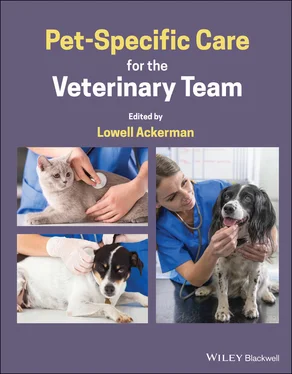It is important for the veterinary healthcare team to reiterate that if pet owners want the most benefit from pet health insurance it should be initiated as quickly as possible, typically by 8 weeks of age, before there are any issues that could be considered preexisting.
Ideally, the first veterinary visit might be made even before the new pet is acquired (see 3.10Advising Clients on Selecting an Appropriate Pet). If a specific breed has been selected, the veterinary team should be able to counsel the owners on possible breed‐related conditions to be aware of (see 11.4Heritable Health Conditions – By Breed), and what documentation would be worthwhile from the provider of the animal (e.g., hip joint certification of parents, DNA testing of parents, etc.). Armed with this information, the situation is established where the veterinary team is the healthcare advocate, and this helps cement an appropriate doctor–client bond.
The veterinary practice will also want to evaluate the previous healthcare that the animal received. For example, many young animals are “dewormed,” have had some initial vaccinations, and perhaps other treatments. As the healthcare advocate, the veterinary team will want to safeguard the owner from any zoonotic conditions, protect any animals at home from infectious diseases (quarantine may be needed), and determine the appropriateness of any treatments to date.
Apart from thorough physical examination, the first visit is a great time to discuss overall healthcare strategies for the months and years ahead. Sometimes this is easier to discuss if the subject matter is broken down into routine healthcare, breed‐related concerns, behavioral counseling, neutering, dental care, nutrition, life stage issues, and unexpected care (emergencies, specialist consultations, etc.). Providing a written healthcare plan streamlines the process and means that the client can listen to instructions and appreciate the “big picture” without trying to take exhaustive notes. Although this might seem overwhelming to the client at first, it does set the stage for the anticipated care of the pet that will span a lifetime. This also helps owners budget accordingly and consider other ways to manage the costs of pet healthcare such as buying pet health insurance (see 10.16Pet Health Insurance).
Many pet owners have unrealistic expectations of pet care because they have never been exposed to optimal care and never had anyone detail pet‐specific care guidelines for them (see 9.3Guidelines). Most are appreciative of these clear‐cut guidelines and the ability to plan in advance for realistic costs as well as which risk management strategies might be most appropriate.
Subsequent visits are opportunities to reinforce the healthcare plan and make any alterations needed on the basis of those visits, diagnostic testing, or treatments. Healthcare plans are dynamic and flexible and may be changed to reflect the realities of the situation. For example, if a Doberman pinscher is screened for von Willebrand disease and found to be at significant risk, this will likely change the process at the time of surgery, as well as the charges associated with such surgery. The identification of cardiomyopathy will change the previous plan regarding the interval between scheduled clinical examinations, and recommendations for ongoing monitoring.
Throughout the process, it is important to have ongoing conversations with pet owners about the important concepts of compliance and adherence. It is not enough that clients be prepared to purchase products from us for use in their pets. They need to understand the critical importance of following directions at home. There is often a lot to discuss with pet owners, and typically limited time during office visits, so successful veterinary teams often rely on convergence schedules to ensure effective communication and owner engagement (see 9.7Continuum of Care and Convergence Schedules).
Care is often delivered on the basis of life stages, and while this varies considerably between individuals, it can be helpful to use approximations based on age and weight ( Tables 1.2.1and 1.2.2); in the future there will likely also be ways to assess genetic aspects of aging (e.g., telomeres, DNA methylation, etc.).
Table 1.2.1 Approximation for converting “dog” years to relative human years, as well as matching life stages based on adult weights
|
<10 kg |
10–20 kg |
20–30 kg |
30–40 kg |
40–50 kg |
>50 kg |
| Age |
Life Stage |
Relative Human Age (Years) |
Life Stage |
Relative Human Age (Years) |
Life Stage |
Relative Human Age (Years) |
Life Stage |
Relative Human Age (Years) |
Life Stage |
Relative Human Age (Years) |
Life Stage |
Relative Human Age (Years) |
| 3 months |
Puppy |
4 |
Puppy |
4 |
Puppy |
3 |
Puppy |
3 |
Puppy |
3 |
Puppy |
3 |
| 6 months |
Puppy |
7 |
Puppy |
7 |
Puppy |
6 |
Puppy |
6 |
Puppy |
6 |
Puppy |
6 |
| 9 months |
Young |
11 |
Young |
11 |
Puppy |
9 |
Puppy |
9 |
Puppy |
9 |
Puppy |
9 |
| 12 months |
Young |
15 |
Young |
15 |
Puppy |
12 |
Puppy |
12 |
Puppy |
12 |
Puppy |
12 |
| 18 months |
Young |
19 |
Young |
19 |
Young |
16 |
Young |
16 |
Puppy |
16 |
Puppy |
16 |
| 2 years |
Young |
24 |
Young |
24 |
Young |
19 |
Young |
19 |
Young |
19 |
Young |
19 |
| 3 years |
Mature |
28 |
Mature |
28 |
Mature |
25 |
Mature |
26 |
Mature |
26 |
Mature |
27 |
| 4 years |
Mature |
32 |
Mature |
32 |
Mature |
30 |
Mature |
32 |
Mature |
33 |
Mature |
35 |
| 5 years |
Mature |
36 |
Mature |
36 |
Mature |
36 |
Mature |
38 |
Mature |
40 |
Senior |
42 |
| 6 years |
Mature |
40 |
Mature |
40 |
Mature |
42 |
Senior |
46 |
Senior |
47 |
Senior |
50 |
| 7 years |
Mature |
44 |
Senior |
45 |
Senior |
48 |
Senior |
53 |
Senior |
54 |
Senior |
56 |
| 8 years |
Senior |
48 |
Senior |
49 |
Senior |
53 |
Senior |
57 |
Senior |
58 |
Senior |
61 |
| 9 years |
Senior |
52 |
Senior |
53 |
Senior |
58 |
Senior |
62 |
Senior |
64 |
Senior |
68 |
| 10 years |
Senior |
56 |
Senior |
57 |
Senior |
63 |
Senior |
67 |
Senior |
69 |
Senior |
75 |
| 11 years |
Senior |
61 |
Senior |
62 |
Senior |
68 |
Senior |
72 |
Senior |
74 |
Senior |
82 |
| 12 years |
Senior |
66 |
Senior |
67 |
Senior |
73 |
Senior |
77 |
Senior |
79 |
Senior |
89 |
| 13 years |
Senior |
71 |
Senior |
73 |
Senior |
78 |
Senior |
82 |
Senior |
83 |
Senior |
91 |
| 14 years |
Senior |
76 |
Senior |
78 |
Senior |
83 |
Senior |
87 |
Senior |
88 |
Senior |
96 |
| 15 years |
Senior |
81 |
Senior |
83 |
Senior |
89 |
Senior |
92 |
Senior |
94 |
Senior |
101 |
| 16 years |
Senior |
86 |
Senior |
88 |
Senior |
95 |
Senior |
98 |
Senior |
100 |
Senior |
106 |
| 17 years |
Senior |
92 |
Senior |
94 |
Senior |
100 |
Senior |
103 |
Senior |
105 |
Senior |
111 |
| 18 years |
Senior |
98 |
Senior |
100 |
Senior |
104 |
Senior |
107 |
Senior |
111 |
Senior |
116 |
| 19 years |
Senior |
104 |
Senior |
105 |
Senior |
108 |
Senior |
111 |
Senior |
113 |
Senior |
121 |
| 20 years |
Senior |
108 |
Senior |
109 |
Senior |
112 |
Senior |
116 |
Senior |
118 |
Senior |
|
| 21 years |
Senior |
112 |
Senior |
114 |
Senior |
116 |
Senior |
120 |
Senior |
|
Senior |
|
| 22 years |
Senior |
116 |
Senior |
120 |
Senior |
122 |
Senior |
|
Senior |
|
Senior |
|
| 23 years |
Senior |
120 |
Senior |
|
Senior |
|
Senior |
|
Senior |
|
Senior |
|
| 24 years |
Senior |
|
Senior |
|
Senior |
|
Senior |
|
Senior |
|
Senior |
|
| 25 years |
Senior |
|
Senior |
|
Senior |
|
Senior |
|
Senior |
|
Senior |
|
Table 1.2.2 Approximation for converting “cat” years to relative human years and applicable life stages. Life stages are based on AAFP‐AAHA Feline Life Stage Guidelines
Читать дальше












